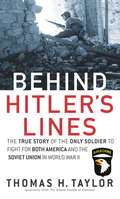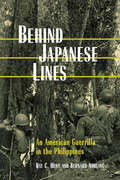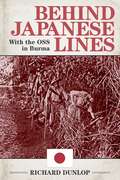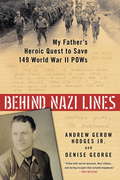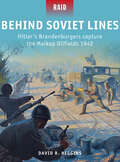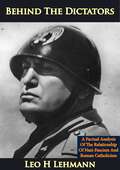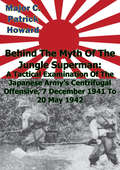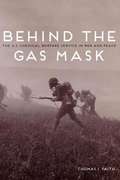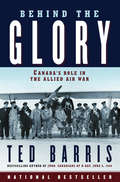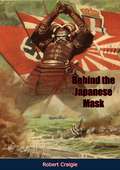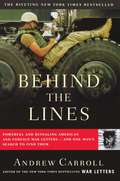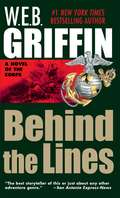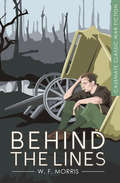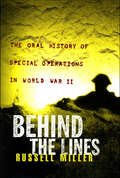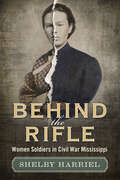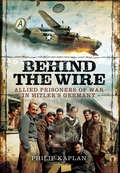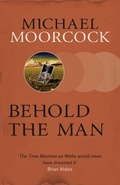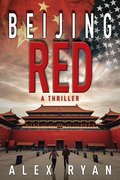- Table View
- List View
Behind Enemy Lines: The World War Two Diary of British Secret Agent Hugh Dormer
by Hugh DormerBehind Enemy Lines: The World War Two Diary of British Secret Agent Hugh Dormer, first published in 1948 as Hugh Dormer's Diaries, is the gripping war-time account of Captain Hugh Everard Dormer, D.S.O., Irish Guards. Dormer twice parachuted into Nazi-occupied France with the objective of destroying an important shale oil processing plant. After each mission, Dormer made his way back to England by crossing into Spain on foot via the Pyrenees Mountains. Following the Normandy invasion, Dormer commanded a British tank crew which was shelled at close-range by a German tank. Dormer and two crewmen managed to escape the burning tank but Dormer was killed by machine-gun fire as he and the crewmen attempted to escape across an open meadow (the other two men were wounded and taken prisoner). Dormer, who was only 25 years old at the time of his death, was remembered fondly by all those who served with him, and had hoped to become a priest following the war. His dedication and heartfelt belief in the moral justness of the Allied cause provide a timeless story of courage and inspiration.
Behind Hitler's Lines: The True Story of the Only Soldier to Fight for both America and the Soviet Union in World War II
by Thomas H. TaylorAs the twentieth century closed, the veterans of its defining war passed away at a rate of a thousand per day. Fortunately, D-Day paratrooper Joseph Beyrle met author Thomas H. Taylor in time to record Behind Hitler's Lines, the true story of the first American paratrooper to land in Normandy and the only soldier to fight for both the United States and the Soviet Union against Nazi Germany. It is a story of battle, followed by a succession of captures, escapes, recaptures, and re-escapes, then battle once more, in the final months of fighting on the Eastern Front. For these unique experiences, both President Bill Clinton and President Boris Yeltsin honored Joe Beyrle on the fiftieth anniversary of V-E Day. Beyrle did not strive to be a part of history, but history kept visiting him. Twice before the invasion he parachuted into Normandy, bearing gold for the French resistance. D Day resulted in his capture, and he was mistaken for a German line-crosser - a soldier who had, in fact, died in the attempt. Eventually Joe was held under guard at the American embassy in Moscow, suspected of being a Nazi assassin. Fingerprints saved him, confirming that he'd been wounded five times, and that he bore a safe-conduct pass written by marshal Zhukov after the Wehrmacht wrested Joe, at gunpoint, from execution by the Gestapo. In the ruins of Warsaw his life was saved again, this time by Polish nuns. Some of Joe's story is in his own words - a voice that will be among the last and best we hear firsthand from World War II.
Behind Japanese Lines: An American Guerrilla in the Philippines
by Ray C. Hunt Bernard NorlingThis WWII combat memoir offers a rare firsthand account of the Allied guerilla forces fighting the Japanese occupation of the Philippines. In the Spring of 1942, US and Philippine forces lost the Battle of Bataan, leaving control of the Bataan Peninsula and the island of Corregidor to the Japanese. After the devastating loss, the Allied forces stationed across the Philippine Archipelago were supposed to surrender. Yet many of them refused, escaping into the mountains and jungles to form guerilla units. In Behind Japanese Lines one of those brave soldiers, Ray Hunt, recounts his experiences as part of the Allied resistance against the Japanese occupation. After escaping the Bataan Death March, Ray organized a troop of guerillas who went on to make noteworthy contributions to the Filipino-American reconquest of the Philippines. Ray&’s story sheds important light on US-Filipino relations during World War II, as well as the realities of fighting both the Imperial Japanese Army and the Hukbalahap communist guerillas."Stands out for the vividness of its detail, its effort to sort fact from legend, and its tribute to the heroism of the resistance movement, which was almost entirely Filipino.&” —Choice
Behind Japanese Lines: With the OSS in Burma
by Richard DunlopIn early 1942, with World War II going badly, President Roosevelt turned to General William "Wild Bill" Donovan, now known historically as the "Father of Central Intelligence," with orders to form a special unit whose primary mission was to prepare for the eventual reopening of the Burma Road linking Burma and China by performing guerilla operations behind the Japanese lines. Thus was born OSS Detachment 101, the first clandestine special force formed by Donovan and one that would play a highly dangerous but vital role in the reconquest of Burma by the Allies.Behind Japanese Lines, originally published in 1979, is the exciting story of the men of Detachment 101, who, with their loyal native allies-the Kachin headhunters-fought a guerilla war for almost three years. It was a war not only against a tough and unyielding enemy, but against the jungle itself, one of the most difficult and dangerous patches of terrain in the world. Exposed to blistering heat and threatened by loathsome tropical diseases, the Western-raised OSS men also found themselves beset by unfriendly tribesmen and surrounded by the jungle's unique perils-giant leeches, cobras, and rogue tigers.Not merely a war narrative, Behind Japanese Lines is an adventure story, the story of unconventional men with an almost impossible mission fighting an irregular war in supremely hostile territory. Drawing upon the author's own experiences as a member of Detachment 101, interviews with surviving 101 members, and classified documents, Dunlop's tale unfolds with cinematic intensity, detailing the danger, tension, and drama of secret warfare. Never before have the activities of the OSS been recorded in such authentic firsthand detail.
Behind Nazi Lines
by Denise George Andrew Gerow HodgesIn 1944, hundreds of Allied soldiers were trapped in POW camps in occupied France. The odds of their survival were long. The odds of escaping, even longer. But one-man had the courage to fight the odds . . . An elite British S.A.S. operative on an assassination mission gone wrong. A Jewish New Yorker injured in a Nazi ambush. An eighteen-year-old Gary Cooper lookalike from Mobile, Alabama. These men and hundreds of other soldiers found themselves in the prisoner-of-war camps off the Atlantic coast of occupied France, fighting brutal conditions and unsympathetic captors. But, miraculously, local villagers were able to smuggle out a message from the camp, one that reached the Allies and sparked a remarkable quest by an unlikely--and truly inspiring--hero. Andy Hodges had been excluded from military service due to a lingering shoulder injury from his college-football days. Devastated but determined, Andy refused to sit at home while his fellow Americans risked their lives, so he joined the Red Cross, volunteering for the toughest assignments on the most dangerous battlefields. In the fall of 1944, Andy was tapped for what sounded like a suicide mission: a desperate attempt to aid the Allied POWs in occupied France--alone and unarmed, matching his wits against the Nazi war machine. Despite the likelihood of failure, Andy did far more than deliver much-needed supplies. By the end of the year, he had negotiated the release of an unprecedented 149 prisoners--leaving no one behind. This is the true story of one man's selflessness, ingenuity, and victory in the face of impossible adversity.
Behind Soviet Lines-Hitler's Brandenburgers capture the Maikop Oilfields 1942
by Johnny Shumate David HigginsWith his forces having conquered a huge swathe of formerly Soviet territory in the months following the launch of Operation Barbarossa in June 1941, Hitler planned to continue the Germans' strategic offensive against the Soviet Union's oil-production capacity in the southern Caucasus region during the summer of 1942. To help pave the way for regular forces, the Abwehr (German military intelligence) sent forward 'Brandenburger' commando units to pave the way using tactics that had proven successful throughout the previous Western and Balkan campaigns. These commandos would secure oil-producing assets until more conventional forces from 1. Panzerarmee and 17. Armee could arrive in strength. Specially trained in foreign cultures and military vehicles, small-unit tactics, parachuting, sabotage, reconnaissance, assassination and deception techniques, these elite commandos usually operated in company-sized units or smaller and recruited many 'non-Aryan' native speakers of those languages spoken in the target countries.In early August 1942, a small Brandenburger unit of Baltic and Sudeten Germans led by Freiherr Adrian von Fölkersam penetrated far ahead of German regular forces to seize Soviet oil facilities around Maikop. Disguised as members of Stalin's NKVD, the repressive police organisation dreaded by most Soviet citizens and soldiers, Fölkersam's command passed through the Soviet front lines using captured trucks and moved deep into hostile territory, where the chaos of the Soviet battlefield situation aided in their passing as 'official'. As regular German forces approached after several days, the Brandenburgers went into action using grenades to simulate an artillery attack before disabling Maikop's military communication network. Having previously seen Fölkersam with their commander, and lacking any communications to rebut or confirm his statement, the Soviets began to evacuate Maikop at Fölkersam's urging. The German spearhead entered the city on 9 August 1942 against minimal resistance and found that several oil-production facilities were still functioning.Featuring specially drawn full-colour artwork and expert analysis of the Maikop operation, this assessment of the dramatic raid that delivered intact Soviet oil-production facilities into Nazi hands casts new light of the German special-forces operations on the Eastern Front.
Behind The Dictators: A Factual Analysis Of The Relationship Of Nazi-Fascism And Roman Catholicism
by Leo H LehmannBehind the Dictators by Leo H. Lehmann is a bold and meticulously researched exploration of the connections between Nazi-Fascist regimes and elements within the Roman Catholic Church. Through compelling analysis and historical documentation, Lehmann delves into the complex relationship between political authoritarianism and religious influence in 20th-century Europe.In this provocative work, Lehmann examines the ideological and practical alliances that emerged between key figures in the Catholic hierarchy and fascist leaders like Adolf Hitler and Benito Mussolini. He explores how shared interests, ranging from anti-communism to the consolidation of power, forged unlikely alliances and influenced the political landscape of the time. Drawing from historical records, speeches, and firsthand accounts, Lehmann provides a detailed and critical account of these interactions, revealing the extent to which religion and politics intersected during one of history’s darkest periods.While unflinching in its critique, Behind the Dictators also contextualizes the broader historical, social, and economic pressures that shaped these alliances. Lehmann’s analysis serves as both a historical study and a cautionary tale about the potential dangers of intertwining religious authority with political power.Ideal for readers interested in history, political science, or the dynamics of religion and power, Behind the Dictators offers a thought-provoking and challenging perspective on the role of institutions during times of upheaval. This book is a compelling resource for anyone seeking to understand the undercurrents that shaped the political and religious alliances of the 20th century.
Behind The Myth Of The Jungle Superman: A Tactical Examination Of The Japanese Army’s Centrifugal Offensive, 7 December 1941 To 20 May 1942
by Major C. Patrick HowardThis thesis studies the successful Japanese Centrifugal Offensive of 1941-42. The Japanese lacked realistic strategic objectives for the offensive, and the Imperial Japanese Army (IJA), which was trained and equipped to fight the Soviet Army on the plains of Manchuria, had neither sufficient logistics structure nor appropriate equipment for a dispersed jungle campaign. Despite these severe strategic and operational failings, IJA tactical units achieved all of their objectives within six months. This study uses government documents, untranslated Japanese sources, and secondary works to examine the conscription system, training methods, equipment, and tactical doctrine that the IJA employed during the Centrifugal Offensive.The study concludes that the IJA's aggressive training methods produced a skilled army that easily adapted to the unfamiliar jungle terrain of the Southwest Pacific. While the IJA's equipment was usually ill suited for battle against the Soviets, Japanese emphasis on light weight unintentionally made the IJA's standard issue items eminently suitable for jungle operations. Likewise, the IJA's doctrine was ideal for a short, offensive jungle campaign. The Centrifugal Offensive provides evidence to the modern military leader that well-trained soldiers will adapt to unfamiliar situations without special training, and that junior leaders can learn initiative through instruction and conditioning.
Behind the Black Door
by Sarah BrownIn this personal memoir about life at 10 Downing Street, Sarah Brown shares the secrets of living behind the most famous front door in the world.Sarah gave up a successful career in business to serve the country. A passionate campaigner for women and children, she mobilised over a million people through her early adoption of Twitter.If you've ever wondered what it's like to pack for a photo call with supermodels or pause a speech in front of hundreds when the autocue fails, it's all here - from what to do when the school play clashes with a visit to the White House to what it feels like to support the man you love as he takes tough decisions to stave off global financial meltdown...Intimate, reflective, surprising and funny, Behind the Black Door takes us backstage to reveal what it's like to be an ordinary woman, wife and mother in extraordinary circumstances.
Behind the Front
by Craig GibsonUntil now scholars have looked for the source of the indomitable Tommy morale on the Western Front in innate British bloody-mindedness and irony, not to mention material concerns such as leave, food, rum, brothels, regimental pride, and male bonding. However, re-examining previously used sources alongside never-before consulted archives, Craig Gibson shifts the focus away from battle and the trenches to times behind the front, where the British intermingled with a vast population of allied civilians, whom Lord Kitchener had instructed the troops to 'avoid'. Besides providing a comprehensive examination of soldiers' encounters with local French and Belgian inhabitants which were not only unavoidable but also challenging, symbiotic and uplifting in equal measure, Gibson contends that such relationships were crucial to how the war was fought on the Western Front and, ultimately, to British victory in 1918. What emerges is a novel interpretation of the British and Dominion soldier at war.
Behind the Gas Mask: The U.S. Chemical Warfare Service in War and Peace
by Thomas I FaithIn Behind the Gas Mask, Thomas Faith offers an institutional history of the Chemical Warfare Service, the department tasked with improving the Army's ability to use and defend against chemical weapons during and after World War One. Taking the CWS's story from the trenches to peacetime, he explores how the CWS's work on chemical warfare continued through the 1920s despite deep opposition to the weapons in both military and civilian circles. As Faith shows, the believers in chemical weapons staffing the CWS allied with supporters in the military, government, and private industry to lobby to add chemical warfare to the country's permanent arsenal. Their argument: poison gas represented an advanced and even humane tool in modern war, while its applications for pest control and crowd control made a chemical capacity relevant in peacetime. But conflict with those aligned against chemical warfare forced the CWS to fight for its institutional life--and ultimately led to the U.S. military's rejection of battlefield chemical weapons.
Behind the Glory: Canada's Role in the Allied Air War
by Ted BarrisIn this 60th anniversary edition is Ted Barris’ telling of the unique story of Canada’s largest World War II expenditure – $1.75 billion in a Commonwealth-wide training scheme, based in Canada that supplied the Allied air war with nearly a quarter of a million qualified airmen. Within its five-year life-span, the BCATP supplied a continuous flow of battle-ready pilots, navigators, wireless radio operators, air gunners, flight engineers, riggers and fitters or more commonly known as ground crew, principally for the RCAF and RAF as well as the USAAF. While the story of so many men graduating from the most impressive air training scheme in history is compelling enough, Ted Barris offers the untold story of the instructors – the men behind the glory – who taught those airmen the vital air force trades that ensure Allied victory over Europe, North Africa and the Pacific. In Winston Churchill’s words, the BCATP proved "the decisive factor" in winning the Second World War. This 60th anniversary edition arrives as Canada continues to celebrate 2005 as the Year of the Veteran. Ted Barris interviewed more than 200 instructors and using their anecdotes and viewpoints he recounts the story of the flyers who coped with the dangers of training missions and the frustration of fighting the war thousands of miles away from the front without losing their enthusiasm for flying.
Behind the Japanese Mask: A British Ambassador In Japan, 1937-1942 (The\kegan Paul Japan Library)
by Robert CraigieBehind the Japanese Mask tells the story of political events in Japan leading up to and during World War II, as told by the British Ambassador in Japan from 1937-1941 himself, Sir Robert Leslie Craigie.“THIS BOOK IS IN NO SENSE AN OFFICIAL RECORD. IT IS RATHER AN ATTEMPT, made without reference to official documents and after three years of mature reflection, to disentangle from avoidable detail the sequence of political events in Japan which led up to the war; to record the main developments in Anglo-Japanese relations during that time; and to follow the intricacies of the struggle in Japan between those who favoured this war of aggression and those who worked against it. Interspersed with political matters I have given accounts of our personal experiences, not because I regard them as intrinsically important, but rather in the hope that they may help to give body to the general impressions formed during those five critical years in Japan. The views expressed are purely my own and in no way commit His Majesty’s Government.“‘Know thine enemy’ is a good precept for those who have been engaged on a life-and-death struggle with a foe who is as inscrutable as he has often shown himself to be unscrupulous. If this book can add but a little to the sum of that knowledge, I shall be more than satisfied.”—Sir Robert Leslie Craigie
Behind the Lines
by Andrew CarrollFrom the editor of the phenomenal New York Times bestseller War Letters comes an even more powerful, more revealing collection of rare and previously-unpublished letters from every major war in American history -- all discovered during Andrew Carroll's extraordinary three-year journey throughout the U.S. and to thirty-five countries around the world."
Behind the Lines
by W.E.B. GriffinBehind the Lines is W. E. B. Griffin's powerful novel of World War II -- and the courage, patriotism, and sacrifice of those who fought it.By 1942, the Japanese have routed the outnumbered American forces and conquered the Philippines. But deep in the island jungles, the combat continues. Refusing to surrender, a renegade Army officer organizes a resistance force and vows to fight to the last man. A Marine leads his team on a mission through the heart of enemy territory. And the nation's proudest sons fight uncelebrated battles that will win -- or lose -- the war . . .
Behind the Lines
by W.E.B. GriffinBehind the Lines is W. E. B. Griffin's powerful novel of World War II -- and the courage, patriotism, and sacrifice of those who fought it.By 1942, the Japanese have routed the outnumbered American forces and conquered the Philippines. But deep in the island jungles, the combat continues. Refusing to surrender, a renegade Army officer organizes a resistance force and vows to fight to the last man. A Marine leads his team on a mission through the heart of enemy territory. And the nation's proudest sons fight uncelebrated battles that will win -- or lose -- the war . . .
Behind the Lines
by W.E.B. GriffinBehind the Lines is W. E. B. Griffin's powerful novel of World War II -- and the courage, patriotism, and sacrifice of those who fought it.By 1942, the Japanese have routed the outnumbered American forces and conquered the Philippines. But deep in the island jungles, the combat continues. Refusing to surrender, a renegade Army officer organizes a resistance force and vows to fight to the last man. A Marine leads his team on a mission through the heart of enemy territory. And the nation's proudest sons fight uncelebrated battles that will win -- or lose -- the war . . .
Behind the Lines: A Novel (Casemate Classic War Fiction #6)
by W. F. MorrisAfter killing a fellow officer, a British World War I fighter joins the ranks of deserters and outlaws in a suspenseful novel from the author of Bretherton.Behind the Lines follows army man Peter Rawley, who accidentally kills an overbearing, taunting fellow officer and, terrified that he will not receive a fair hearing amid the chaos of the trenches, flees the battlefield. Now a fugitive, Rawley must join forces with other deserters, criminals, and lost soldiers in a hand-to-mouth existence, trying to survive in the no-man&’s-land between opposing armies. He will encounter both adventure and disaster, including capture by the Germans and the threat of a firing squad—and will need to call upon his own bravery and the support of the woman he loves to survive. A thriller from the author of Bretherton: Khaki or Field-Grey?—which was praised by the Sunday Times as &“a mystery as exciting as a good detective story and an extraordinarily vivid account of trench-warfare&”—this is a meditation on the issues of identity and allegiance, as well as the role of chance. Behind the Lines is a classic of WWI fiction and an exciting read that brings the drama of the Great War to life.
Behind the Lines: The Oral History of Special Operations in World War II
by Russell MillerThis is the story of special operations in the second world war as it has never been told before--directly by those who took part.Compiled by Russell Miller from interviews, diaries, letters and contemporaneous first-person accounts--many unpublished until now--the oral history in Behind the Lines follows the adventures of the courageous men and women who volunteered for service with the Untied States' Office of Strategic Services and Britain's Special Operations Executive. They parachuted behind enemy lines, often alone, with orders to cause mayhem. Arrest almost always resulted in torture and imprisonment; sometimes in execution.Trained in the black arts of warfare--sabotage, subversion, espionage, guerrilla tactics and undermining enemy morale by the distribution of insidious propaganda--theirs was a war fought in the shadows. Their activities extended to every theatre of operations: in occupied France, equipped with false identities, they played a deadly game of cat and mouse with the Gestapo; in the Balkans they discovered that the fiery politics of the region were as dangerous as the enemy; in the Burmese jungle, in some of the worst combat conditions of the war, they led native marauders in surprise attacks against the Japanese. From Britain they were supported by a team of back-room inventors who produced expertly forged documents and dreamed up ingenious devices like exploding rats and invisible ink. The special agents of World War Two really were a breed apart. This is their extraordinary story. In their own words.
Behind the Rifle: Women Soldiers in Civil War Mississippi
by Shelby Harriel-HidlebaughDuring the Civil War, Mississippi’s strategic location bordering the Mississippi River and the state’s system of railroads drew the attention of opposing forces who clashed in major battles for control over these resources. The names of these engagements—Vicksburg, Jackson, Port Gibson, Corinth, Iuka, Tupelo, and Brice’s Crossroads—along with the narratives of the men who fought there resonate in Civil War literature. However, Mississippi’s chronicle of military involvement in the Civil War is not one of men alone. Surprisingly, there were a number of female soldiers disguised as males who stood shoulder to shoulder with them on the firing lines across the state. Behind the Rifle: Women Soldiers in Civil War Mississippi is a groundbreaking study that discusses women soldiers with a connection to Mississippi—either those who hailed from the Magnolia State or those from elsewhere who fought in Mississippi battles. Readers will learn who they were, why they chose to fight at a time when military service for women was banned, and the horrors they experienced. Included are two maps and over twenty period photographs of locations relative to the stories of these female fighters along with images of some of the women themselves. The product of over ten years of research, this work provides new details of formerly recorded female fighters, debunks some cases, and introduces over twenty previously undocumented ones. Among these are women soldiers who were involved in such battles beyond Mississippi as Shiloh, Antietam, and Gettysburg. Readers will also find new documentation regarding female fighters held as prisoners of war in such notorious prisons as Andersonville.
Behind the Wire: Allied Prisoners of War in Hitler’s Germany
by Philip KaplanPhilip Kaplan presents us here with a riveting account of the Allied experience behind enemy lines, detailing the trials and tribulations experienced by the British and American airmen who were shot down in European skies during World War Two, to be incarcerated 'behind the wire' in enemy camps. With eloquence and a clear enthusiasm for the subject at hand, the author describes how various individuals adjusted to their incarceration. Whilst some set their minds resolutely on escape, and dreamt up plots and plans to achieve this end, others retreated, away from their comrades and into themselves as the grim reality of their predicament pushed them ever deeper into debilitating depression. Others were determined that they would not waste their time; affected by the quick and brutal deaths they had witnessed during their wartime careers, they were unwilling to sit idle. Theatres, recreational areas, and other camp facilities were designed and built a creative spur that made their time behind the wire, and the quality of life of their fellow comrades, infinitely more bearable. These small acts of enterprising heroism, alongside the harrowing tales of those who crumpled under the weight of their prison reality, combine to create a complete picture of this collective experience. Kaplan's skill lies in informing the reader of the facts of this history with both honesty and reverence.
Behind the Wire: Prisoners of War 1914-18
by Robert JacksonA unique story of POWs in World War I. Covering traumatic capture on the battlefield, internment in POW camps, escape attempts, punishments, day-to-day boredom and meagre rations, Behind the Wire is a gripping, comprehensive history of the remarkable experiences of POWs in the First World War. Opening with the desperate scene of the brutally cold, wind-swept POW camp at Wittenburg in December 1914, where 16,000 prisoners were dying in from exposure and malnutrition, Jackson weaves together official reports and first-hand accounts to reveal the immense challenges faced by all belligerent nations in housing their prisoners of war, and how the men behind the wire did all they could to survive and one day return home.
Behold The Man
by Michael MoorcockMeet Karl Glogauer, time traveller and unlikely Messiah. When he finds himself in Palestine in the year 29AD he is shocked to meet the man known as Jesus Christ - a drooling idiot, hiding in the shadows of the carpenter's shop in Nazareth. But if he is not capable of fulfilling his historical role, then who will take his place?Expanded from the Nebula-winning 1966 novella, BEHOLD THE MAN is one of the greatest books of Moorcock's long and varied career. Intense, delicate and brutal, it explores the psyche of one man as he faces his ultimate fate. One he knows he cannot avoid.
Beijing Red (A Nick Foley Thriller)
by Alex RyanWhen ex-Navy SEAL Nick Foley travels to China to find purpose and escape the demons of his past, he instead stumbles into a conspiracy his Special Forces training never prepared him for. A mysterious and deadly outbreak ravages a remote area of western China, and Nick finds himself the lead suspect in a bio-terrorism investigation being conducted by China's elite Snow Leopard counter-terrorism unit.To clear his name and avoid prosecution, he must team up with beautiful Chinese CDC microbiologist Dr. Dazhong "Dash" Chen to find who is really behind the attack. As their investigation proceeds, their budding friendship is tested by nationalistic loyalties and suspicion.In a race against time, Nick and Dash must risk everything to stop a mad man before he unleashes the world's next super-weapon in Beijing.
Beirut Diary
by Charles L. BreindelThe book recounts Dr. Breindel's professorship in Beirut in 1982, how fighting broke out, and how he and others were daptured. The book shows how the experience changed his life. Really interesting. "This book has been a long time in formulation. It has been an idea gestating in my mind and in those of many dear friends who wanted to hear the story of my third and final trip to the American University of Beirut. It was well known by many that I kept detailed diaries during those early days of international travel. Because of that, many have been requesting the publication of the diary from that fateful trip 23 years ago. But I was not ready to share my story, nor the significance that those days in Beirut in the spring of 1982 had on my life. I was still an "open book," naive and looking for meaning in life, after I got back home. What I found in Beirut was not apparent to me until many years later when good hindsight brought into better perspective the life-changing experience of Beirut. I went to Beirut as a young visiting assistant professor to teach a short course in health planning. I returned still the same professional, but with a different worldview, a budding sense of God in my life, and a new hunger for understanding and wisdom that was unparalleled in my prior life. Before Beirut, I was "putting in time," existing, not being particularly satisfied, yet not dissatisfied. Not knowing the possibilities available in my life, I was unaware that there were other possibilities, other realities."

